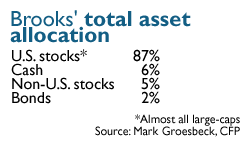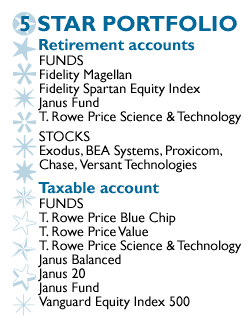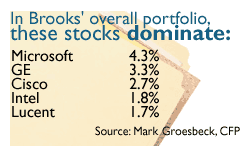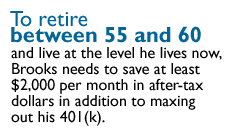|
Keep the affluence going
|
 |
June 19, 2000: 11:05 a.m. ET
Meeting retirement goals takes commitment, even on a big salary
By Staff Writer Jeanne Sahadi
|
NEW YORK (CNNfn) - Glen Brooks and his wife, Kim, are looking forward to splitting their time in retirement between condominiums in Hilton Head, S.C., and central Connecticut, where they currently live in a four-bedroom house with their two young daughters. They hope to retire between 55 and 60.
Although he has never consulted with financial planners, Brooks, 36, suspects they would tell him three things about his $225,000 portfolio: He is overweighted in technology; his funds have a lot of the same top holdings; and he needs more international exposure.
Brooks is partially right. He doesn't have as much exposure to technology as he thinks, and planners say his retirement goals are within reach. But they also recommend that as the family's sole breadwinner and financial manager, Brooks has to be even more disciplined about his savings and better diversify his investments to weather market declines.
Figuring out the best portfolio for you
Financial experts recommend that investors keep their long-term portfolios diversified across sectors, investment styles and asset classes so that they can benefit from the parts of the market doing well while not tying the bulk of their fortunes to those segments faring poorly.
 Portfolio Rx, debuting this week, will run twice a month on CNNfn.com. Readers who want help with their asset allocation are invited to write in. If chosen, financial planning experts selected by CNNfn.com will review your holdings, your retirement goals and offer advice about how best you can meet those goals. See below for details. Portfolio Rx, debuting this week, will run twice a month on CNNfn.com. Readers who want help with their asset allocation are invited to write in. If chosen, financial planning experts selected by CNNfn.com will review your holdings, your retirement goals and offer advice about how best you can meet those goals. See below for details.
That can mean having healthy levels of exposure to stocks, bonds and cash; domestic and international equities; large-cap, mid-cap and small-cap companies; and industries ranging from agriculture to technology.
Of course, there is no one model of asset allocation that's right for everyone. What's best for you depends on several factors -- your age, for one. The younger you are, the more aggressive you can afford to be.
 But some people, no matter how young, can't sleep at night if they think their investments might lose half their value when the market is volatile. So risk tolerance is another important consideration. But some people, no matter how young, can't sleep at night if they think their investments might lose half their value when the market is volatile. So risk tolerance is another important consideration.
And personal investment philosophies are key as well. Before taking his current position as a salesman for an Internet-based professional services firm last year, Brooks spent 10 years selling software. His career in technology-based businesses has heavily influenced his investment choices.
"I've got a very strong belief that technology is going to play a bigger and bigger role," he said.
Tech is in line with S&P
And his portfolio demonstrates that belief. The majority of his holdings are in technology-heavy Janus or T. Rowe Price funds, as well as a handful of technology stocks.
 But based on the dollar amounts he has invested in each of them, technology represents only about 33 percent of his overall portfolio. But based on the dollar amounts he has invested in each of them, technology represents only about 33 percent of his overall portfolio.
"That's in line with the technology weighting on the S&P 500 Index," said certified financial planner (CFP) Mark Groesbeck, who works with Stanford Group Co. in Houston.
Brooks' portfolio, which gets a five-star ranking when run through Morningstar's portfolio analyzer, has outperformed the S&P 500 Index by 14 percent over the past year and 3 percent annually over the past three years.
"He's picked well," Groesbeck said.
Think small and go wide
Nevertheless, Brooks was correct to assume he has too little international exposure. U.S. stocks account for 87 percent of his portfolio, while non-U.S. stocks take up a mere 5 percent.
Given Brooks' age and relatively high tolerance for risk, "I would classify him as a growth-type investor," Groesbeck said, suggesting he have about 15 percent to 20 percent of his holdings in international equities.
 A diversified international fund such as American Funds' EuroPacific Growth or Manager International, he said, would give him a broad sampling of investment opportunities across sectors and investment styles. A diversified international fund such as American Funds' EuroPacific Growth or Manager International, he said, would give him a broad sampling of investment opportunities across sectors and investment styles.
Groesbeck and CFP Heather Locus of Balasa & Hoffman in Schaumburg, Ill., also recommend Brooks add small-cap exposure, since his holdings are mostly large caps. The value-oriented State Street Aurora Fund or Berger Small Cap Growth might make good bets, Groesbeck said.
Heavy bets on Microsoft, GE and Cisco
By increasing his international and small-cap holdings, Brooks naturally will diversify away from some of the large-cap stocks that currently dominate his portfolio, given his current fund choices.
As things stand, Microsoft accounts for 4.3 percent of his overall portfolio, General Electric takes up 3.3 percent, and Cisco 2.7 percent. While all of those companies are solid investments, they account for a disproportionate amount of his money.
Brooks' retirement outlook
Brooks' retirement goals and his shorter-term plans, such as paying for his daughters' college education, are well within reach given his high earnings, the planners said -- but not unless he gets more disciplined about investing more of his money on a more regular basis.
Paid a base salary of $80,000 plus commission, his income ranges between $230,000 and $350,000 a year. He has $162,000 in an IRA, $10,000 in his 401(k), and $53,000 in taxable mutual funds earmarked for college funding and a new pool.
In addition, Brooks' company, while it does not offer matching contributions in his 401(k), did give him 25,000 options, currently valued at $25,000, a factor that could be neutral to his long-term savings, or very positive if the company does well, Locus said.
Based on his employment so far, he will not have a pension coming to him, though his wife will receive one from her 13 years working as an ultrasound technician. They're not certain of the amount, but Brooks assumes it won't be much.
As for Social Security benefits, Brooks is not holding his breath. "I totally discount that," he said.
Savings have to be locked in
Despite having a fairly sizeable portfolio for a 36-year-old, Brooks has to be careful.
"He's spending it just as much as he's saving it," Locus said.
It's not uncommon, planners say, for their clients not to realize just how much they spend. At first, Brooks figured he paid about $20,000 a year in credit card bills, but when he did the math he found out the amount was closer to $54,000. "That was kind of enlightening," he said.
 Since his monthly income can be uneven, he normally invests whatever he has left over after paying monthly expenses, which total about $11,500, including the mortgage, car loans and credit cards. Since his monthly income can be uneven, he normally invests whatever he has left over after paying monthly expenses, which total about $11,500, including the mortgage, car loans and credit cards.
But that's too risky, Locus said. Instead, she suggests that in addition to his 401(k) contributions, which he maxes out, he should plan to invest $24,000 a year for retirement. And she recommends doing that by automatically deducting the money from his bank account at the beginning of every month, so that it's a given rather than a maybe.
"If he has other (shorter-term) goals, such as a bigger house, that needs to be on top of the $2,000 a month," she said.
Kim Brooks needs her own IRA
Assuming a 9 percent return on his money and after-tax expenses of $84,000 a year in retirement, Brooks could retire when he is 58, Locus said. Assuming a 10 percent return, Groesbeck added, he could retire at 55.
Of the $24,000 he commits to retirement savings, the bulk should go into tax-efficient mutual funds such as those offered by Vanguard, Locus said.
But $4,000 should go into IRAs for him and his wife.
Although Kim Brooks is a stay-at-home mother, she is allowed to contribute up to $2,000 a year into her own IRA, something both Locus and Groesbeck recommend. But since Brooks' income level exceeds $160,000, neither he nor his wife is allowed to deduct contributions.
Account for emergencies
Brooks' retirement savings can be even greater if he managed his shorter-term expenses more effectively.
Given Brooks' uneven cash flow combined with the fickle fortunes of the Internet world, both Locus and Groesbeck said he should keep more emergency money on hand. With roughly $7,300 in checking and money market savings accounts, Brooks needs to have at least four times that, or about 10 percent of his income, in the event he has a dry spell or his company goes under.
He tends to keep a running balance of $7,000 or so on his major credit cards, only paying them off during his more flush months. But he might be better off using some money from his enlarged emergency account to pay off the cards to avoid finance charges, Groesbeck said.
Make better use of the taxable funds
Given Brooks' salary and the fact that he has been contributing only to his taxable funds account and not his IRA, Locus is surprised he doesn't have more than $53,000 socked away. That money, she and Groesbeck agreed, could be put to better use if he did not use $30,000 to pay for a new pool.
If the pool is not optional, Brooks might consider taking a home equity loan, which may be cheaper than the cost of taking his money out of the market, Groesbeck suggested.
If he did pull out the $30,000, leaving only $23,000 for the kids' education, then Brooks will need to contribute at least $1,200 a month from now on to fund his children's college educations, presuming he wants to send them to private schools, they said.
Insure a happy ending
Brooks and his wife are fortunate to be able to enjoy a very comfortable lifestyle now and are in a position to do so in their later years, if they play their cards right. "He is in reasonable shape," Locus said.
Both she and Groesbeck remarked on his conscientiousness about saving and willingness to pay off his debt. Combined with some of their suggestions, they are confident his big fear will not come true.
When it comes to retirement, there is one thing Brooks really wants to avoid, he said. "I don't want to be caught with my pants down."
* Disclaimer
If you want to be considered for our Portfolio Rx feature, send us an email at retirement@cnnfn.com. Please include your age, occupation, income, assets, debt and expenses. In addition, please tell us about your retirement goals, such as when you wish to retire and what type of lifestyle you envision. Also include specifics about your long-term savings portfolio: your 401(k) and IRA accounts; which mutual funds, stocks and other securities you own; and information about any other source of retirement income you expect, such as a pension. 
|
|
|
|
|
 |

|

